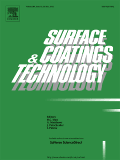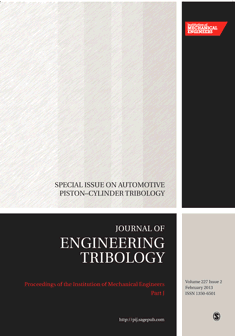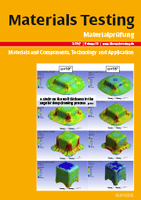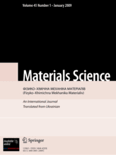
Friction
Scope & Guideline
Leading the Charge in Surface Engineering Discoveries
Introduction
Aims and Scopes
- Tribological Mechanisms and Materials:
Research on the fundamental mechanisms of friction and wear, including the development of advanced materials such as nanostructured coatings, lubricants, and additives aimed at reducing friction and enhancing wear resistance. - Experimental Techniques in Tribology:
Utilization of a variety of experimental techniques, including atomic force microscopy (AFM), tribometers, and advanced imaging methods to investigate frictional behavior at different scales and under various conditions. - Applications in Biomedical and Industrial Fields:
Exploration of tribological issues in biomedical applications (e.g., joint prosthetics, dental materials) and industrial machinery (e.g., bearings, gears), focusing on material performance and longevity. - Modeling and Simulation:
Development of theoretical models and computational simulations to predict tribological behavior, including machine learning approaches that enhance the predictive capability for material interactions under different lubrication conditions. - Environmental and Sustainable Lubrication Solutions:
Research aimed at developing eco-friendly lubricants and understanding the impact of additives on the environment, promoting sustainability in lubrication technologies.
Trending and Emerging
- Nanomaterials and Nanocomposites:
A significant increase in studies involving nanomaterials and their application as lubricant additives or coatings, emphasizing their potential to enhance tribological performance through unique properties at the nanoscale. - Biotribology and Biomedical Applications:
Growing interest in biotribology, particularly the study of lubrication in biological systems and the development of biomimetic materials for medical applications, reflects an interdisciplinary approach bridging tribology and biology. - Sustainable and Green Lubricants:
An emerging trend towards researching biodegradable and environmentally friendly lubricants, driven by increased awareness of sustainability and environmental impact in industrial applications. - Machine Learning and AI in Tribology:
The application of machine learning and artificial intelligence algorithms in predicting tribological properties and optimizing lubrication conditions is gaining traction, marking a significant shift towards data-driven approaches. - Advanced Coatings and Surface Engineering:
Research on innovative surface treatments and coatings designed to improve lubrication and wear resistance has become prominent, highlighting advancements in surface engineering technologies.
Declining or Waning
- Traditional Lubrication Methods:
There seems to be a declining emphasis on conventional lubrication techniques, as the field increasingly explores innovative alternatives and advanced materials that offer superior performance. - Basic Friction Studies Without Application Context:
Research focused solely on basic friction phenomena without direct application implications appears to be less frequent, as the journal shifts towards studies that demonstrate practical relevance and application-based outcomes. - Single-Phase Lubricants:
The focus on single-phase lubricants is waning as there is a growing interest in hybrid or multifunctional lubricants that can provide multiple benefits in tribological performance. - Fretting Wear Studies:
Although still relevant, the frequency of dedicated studies on fretting wear mechanisms has decreased, likely due to the emergence of new areas of interest such as tribochemical processes and advanced coatings.
Similar Journals

Frontiers of Mechanical Engineering
Exploring New Dimensions in Mechanical Engineering ResearchFrontiers of Mechanical Engineering is a premier journal dedicated to advancing the field of mechanical engineering, published by HIGHER EDUCATION PRESS. Located in Beijing, China, this esteemed journal has been a vital platform for innovative research since its establishment in 2011 and continues to contribute significantly to the scientific community with its convergence of studies extending through 2024. With an impressive Q1 ranking in mechanical engineering and a strong placement in the Scopus rankings (#108 out of 672, 84th percentile), the journal showcases high-impact articles that drive forward the knowledge frontier in areas such as thermodynamics, fluid mechanics, and material science. Although it operates on an open-access model, Frontiers of Mechanical Engineering is committed to making significant research universally accessible, ensuring that findings from esteemed researchers reach academic and industrial audiences alike. This journal not only plays a crucial role in disseminating cutting-edge mechanical engineering research but also fosters collaboration between academia and industry experts striving towards innovation and excellence in engineering practices.

SURFACE & COATINGS TECHNOLOGY
Driving Innovation in Chemistry and Materials ScienceSURFACE & COATINGS TECHNOLOGY is a premier academic journal that has been at the forefront of research and innovation since its inception in 1986, diligently published by Elsevier Science SA. With an impressive range of studies focusing on surface and coatings technologies, the journal has established itself as a leading platform within the fields of Chemistry, Condensed Matter Physics, and Materials Science. Notably, it holds a distinguished Q1 ranking in multiple categories, showcasing its relevance and high impact in the academic community. Furthermore, it is recognized for its rigorous peer-review process and is indexed in esteemed databases, maintaining its strong position with a ranking of #17 in Surfaces, Coatings, and Films. Although the journal does not currently offer open access options, it continues to be a crucial resource for researchers, professionals, and students seeking insights into cutting-edge developments and applications in the domain of surface engineering. With a commitment to advancing knowledge across these disciplines, SURFACE & COATINGS TECHNOLOGY is an essential read for anyone interested in the latest trends and technologies shaping the industry.

Tribology International
Fostering Innovation in Mechanical Engineering and Materials.Tribology International, published by ELSEVIER SCI LTD, stands as a premier journal in the fields of tribology, mechanical engineering, and material science. With an impressive impact factor and ranking in the Q1 category across multiple disciplines such as Mechanical Engineering and Surfaces, Coatings and Films, this journal serves as a critical resource for researchers, professionals, and students looking to advance their knowledge and application of tribological principles. Established in 1972, Tribology International explores a wide array of topics, including friction, wear, and lubrication, making it indispensable for those dedicated to innovation in engineering and materials sciences. With its rigorous peer-review process and high visibility within the academic community, Tribology International is pivotal in disseminating influential research, fostering new ideas, and shaping the future of tribological research.

Obrabotka Metallov-Metal Working and Material Science
Unlocking Potential in Metal Working and MaterialsObrabotka Metallov-Metal Working and Material Science is a pivotal journal published by Novosibirsk State Technical University, focusing on the dynamic fields of mechanical engineering, mechanics of materials, and the science of metals and alloys. With ISSN 1994-6309 and E-ISSN 2541-819X, the journal serves as a crucial platform for disseminating research from Russia and around the globe. Currently classified in the Q4 category for Mechanical Engineering and Mechanics of Materials, as well as Q3 for Metals and Alloys, it encompasses a wide range of studies from fundamental research to innovative applications. Despite its relatively recent inception in 2019, the journal has established itself with Scopus rankings that highlight its growing influence—Rank #122 out of 176 in Materials Science and Rank #510 out of 672 in Engineering. This journal aims to foster collaboration among researchers, professionals, and students by featuring original articles, reviews, and technical notes that address contemporary challenges in metal processing and material science. As it continues to evolve through 2024, Obrabotka Metallov remains dedicated to enhancing the understanding and application of materials science, making it a significant resource for those invested in the future of engineering and technology.

PROCEEDINGS OF THE INSTITUTION OF MECHANICAL ENGINEERS PART J-JOURNAL OF ENGINEERING TRIBOLOGY
Fostering collaboration in the pursuit of tribological breakthroughs.PROCEEDINGS OF THE INSTITUTION OF MECHANICAL ENGINEERS PART J: JOURNAL OF ENGINEERING TRIBOLOGY is a premier scholarly publication dedicated to the intricate field of tribology, which encompasses the study of friction, wear, and lubrication in mechanical systems. Published by SAGE Publications Ltd, this journal aims to advance the scientific understanding and application of tribological principles across various industries, particularly in mechanical engineering. With an impressive impact factor and classified in the Q2 and Q3 quartiles in its respective categories, it provides a vital platform for disseminating innovative research and technical advancements. The journal spans over a rich timeline from 1994 to 2024, signifying its longstanding contribution to the academic community. It invites original research articles, comprehensive reviews, and insightful case studies that push the boundaries of existing knowledge and foster collaborative efforts among researchers, professionals, and students in the field. For those engaged in mechanical engineering and materials science, the journal offers unparalleled access to cutting-edge research that can inform and enhance practical applications in the industry.

Materials Testing
Pioneering Innovations in Material PerformanceMaterials Testing is a renowned journal published by Walter de Gruyter GmbH, serving the global scientific community in the fields of Materials Science, Mechanical Engineering, and Mechanics of Materials. With an ISSN of 0025-5300 and an E-ISSN of 2195-8572, this journal has been a significant contributor to the discourse on material performance, testing methodologies, and engineering innovations since its inception. The journal is recognized for its rigorous peer-review process and holds a commendable Q2 quartile ranking in multiple categories for 2023, showcasing its impact and relevance in the field. With open access options available, Materials Testing aims to disseminate valuable research findings and practical insights that drive advancements in technology and materials applications. By addressing the latest challenges and developments within the field, this publication serves as an essential resource for researchers, professionals, and students alike, fostering a deeper understanding of material properties and testing techniques.

Journal of Friction and Wear
Exploring the Dynamics of Friction and WearJournal of Friction and Wear, published by PLEIADES PUBLISHING INC, is a pivotal resource in the field of mechanical engineering, with a particular emphasis on the study of friction, wear mechanisms, and their implications in various materials. With an ISSN of 1068-3666 and an E-ISSN of 1934-9386, this journal provides a platform for cutting-edge research and reviews that contribute significantly to our understanding in these areas. Although currently classified under Q3 in both Mechanics of Materials and Surfaces, Coatings and Films, the journal is making strides towards higher rankings, reflecting its growing influence as it publishes comprehensive analyses and innovative findings. Researchers and professionals can access vital studies, offering insights into improving material durability and performance, integral to numerous industries. This journal serves as a key reference point for students and scholars alike, supporting their quest for knowledge in the evolving landscape of material science.

MATERIALS SCIENCE
Advancing the Frontiers of Materials Science.MATERIALS SCIENCE, a prominent journal published by SPRINGER, serves as a vital resource for researchers, professionals, and students in the fields of materials science, mechanical engineering, and condensed matter physics. With its ISSN 1068-820X and E-ISSN 1573-885X, this journal has been dedicated to sharing innovative research since its inception in 1993, and it continues to publish groundbreaking findings through 2024. Although it operates as a traditional subscription-based journal, its ranking in the Q3 quartile across multiple scientific categories, including Condensed Matter Physics, Materials Science, Mechanical Engineering, and Mechanics of Materials, signifies its relevance and impact in the academic community. Notably, its Scopus classifications reveal a competitive standing among its peers, ranking within the 25th to 33rd percentiles across various engineering and physics disciplines. The journal remains a key platform for disseminating valuable insights, fostering collaboration, and advancing the understanding of materials science.

Surface Topography-Metrology and Properties
Connecting metrology with material performance for a brighter future.Surface Topography-Metrology and Properties is an esteemed journal published by IOP Publishing Ltd, dedicated to advancing the field of surface metrology and its interrelation with material properties. With an ISSN of 2051-672X, this journal serves as a pivotal platform for researchers, professionals, and students engaged in the study of surfaces and coatings, particularly in disciplines such as Instrumentation, Materials Chemistry, and Process Chemistry and Technology. The journal maintains a strong academic presence with notable Category Quartile rankings, including Q2 in Materials Chemistry and Surfaces, Coatings and Films, and Q3 in other relevant fields. Although the journal operates under a subscription model, it offers valuable insights and findings that are crucial for advancing technologies reliant on surface characteristics and functionalities. Since its inception in 2013, the journal has continued to publish high-quality research up to the present day, catering to the ongoing needs of the scientific community and contributing significantly to the discourse in surface science.

Jurnal Tribologi
Advancing tribological knowledge for a sustainable future.Jurnal Tribologi, published by the MALAYSIAN TRIBOLOGY SOC-MYTRIBOS, stands as a pivotal platform for research in the interdisciplinary field of tribology—focusing on the friction, wear, and lubrication of materials. Established in Malaysia and embracing Open Access since 2014, this journal serves a diverse readership and enables worldwide accessibility to cutting-edge research. With an ISSN of 2289-7232, it is indexed across various categories, achieving a commendable Q3 ranking in materials chemistry, mechanical engineering, and several other pertinent fields for 2023. The journal’s commitment to advancing knowledge in its domain is reflected in its circulation of valuable research findings and innovative methodologies, vital for both academic and industry professionals. Researchers, students, and practitioners alike will find Jurnal Tribologi an essential resource, advancing their understanding and application of tribological systems from 2019 to 2024 and beyond.